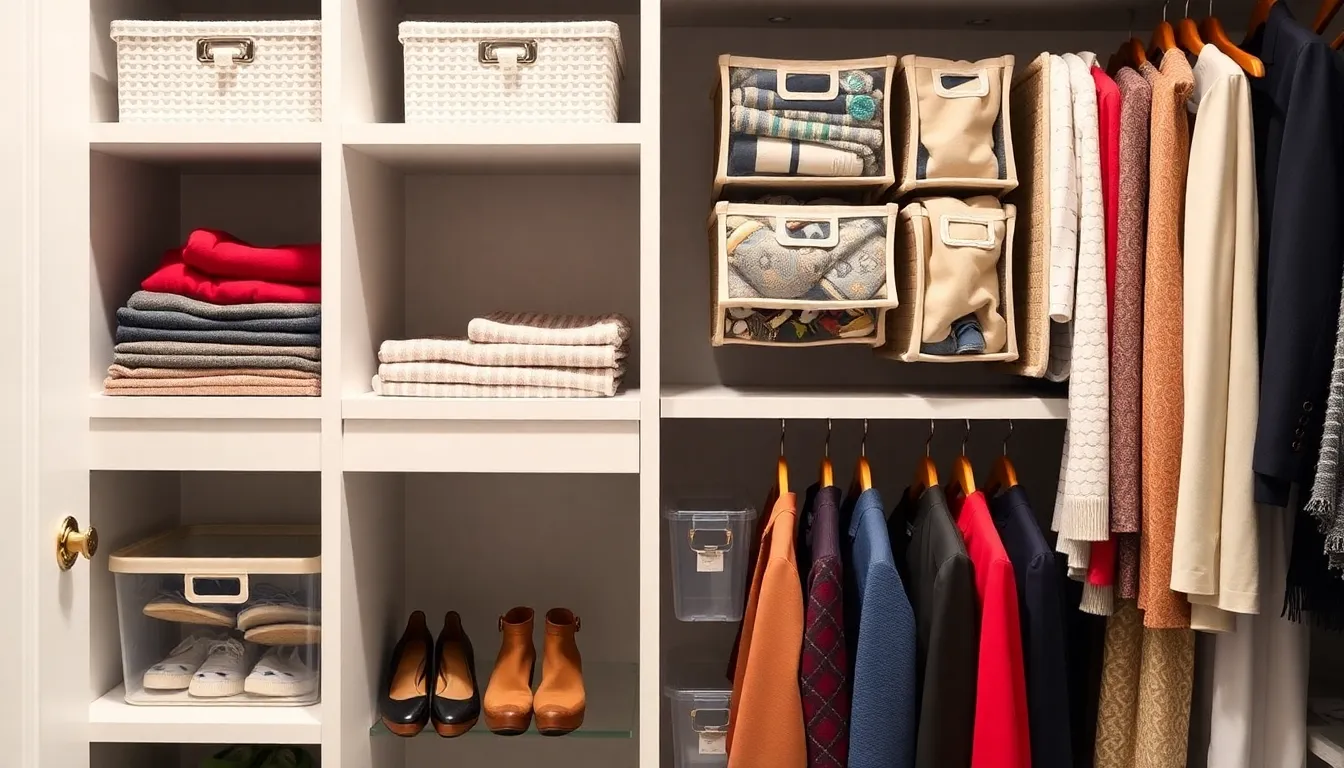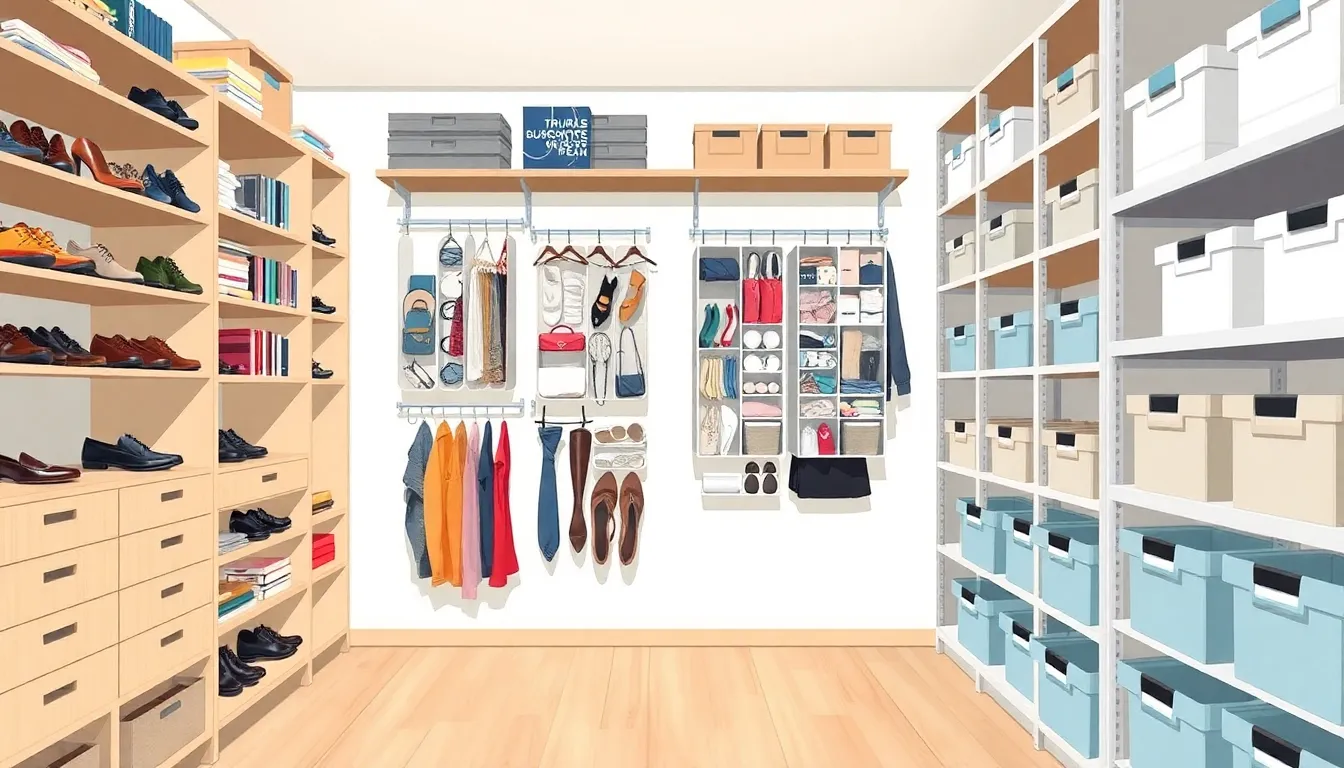Closets can sometimes feel like black holes where clothes, shoes, and various odds and ends mysteriously vanish. If you’ve ever wrestled with a stubborn shoe that decided to play hide-and-seek or dug through a mountain of sweaters to find that one favorite, you know the struggle is real. But fear not! Transforming your closet from a chaotic abyss into a well-organized sanctuary is just a few clever ideas away.
Table of Contents
ToggleUnderstanding Closet Storage Needs
Closets serve various purposes, and understanding their storage needs helps optimize organization. Clever strategies can transform cluttered spaces into efficient storage solutions.
Assessing Available Space
Evaluating closet dimensions provides insight into storage options. Measure width, height, and depth accurately for better planning. Consider any irregularities in shape or fixtures like rods and shelves. Utilizing vertical space often maximizes capacity. Think about the location of door swings and the accessibility of items. Organizing based on space allows for tailored solutions.
Identifying Personal Storage Requirements
Recognizing individual storage needs guides the organization process. List frequently used items alongside seasonal clothing or special occasion pieces. Prioritize visibility for daily essentials, using bins or baskets for smaller accessories. Allocate space for different categories, such as shoes, clothing, and personal items. By identifying needs, one can create an organized system that enhances functionality and accommodates personal preferences.
Creative Closet Storage Ideas


Transforming a cluttered closet into an organized space requires creativity and functionality. Some practical solutions effectively optimize storage and enhance accessibility.
Vertical Storage Solutions
Maximizing vertical space provides significant advantages. Wall-mounted shelves accommodate books and shoes. Hanging organizers can hold accessories and small items. Tension rods positioned vertically create additional space for scarves or ties. Storage bins stacked on shelves ensure efficient use of height. Installing hooks allows for quick access to bags or hats. Utilizing the uppermost areas, such as the top shelf, offers storage for infrequently used items. Assessing closet dimensions helps identify how much vertical space is available for these solutions.
Utilizing Underneath Space
Underneath space often goes unnoticed in closets. It can serve as a practical storage solution. Storage containers placed under hanging clothes store seasonal items efficiently. Rolling bins slide under the bed for extra space management. Drawer dividers help organize smaller items and keep everything neatly stored. An extra shoe rack can fit in this area, maximizing shoe storage capacity. Using clear bins helps in identifying contents without opening every container. Prioritizing this space prevents clutter and enhances overall organization in the closet.
Organizing Your Closet
Organizing a closet requires thoughtful planning and execution. Prioritizing sorting and categorizing items makes a significant difference in maintaining order.
Sorting and Categorizing Items
Begin by assessing every item in the closet. Clothes, shoes, and accessories can often be grouped into categories for efficiency. She recommends creating designated sections for everyday wear, seasonal clothing, and special occasions to streamline access. Identifying favorites or essentials can help in determining what stays and what goes. Using bins or baskets reinforces this system, allowing for a cleaner look while keeping similar items together. Decluttering unnecessary items accelerates the organization process, creating more accessible spaces tailored to individual needs.
Implementing Labeling Systems
Establishing a labeling system enhances visibility and organization. Clear labels on storage bins, shelves, or drawers simplify the search for specific items. Using color-coded labels adds a visual element that can further streamline the process. Include details like size, category, or season to eliminate confusion. Labels promote accountability in maintaining the organized system over time. Updating labels as items change can prevent mishaps in functionality while preserving the initial organization. Each step with labeling contributes to a more efficient and user-friendly closet experience.
DIY Closet Storage Projects
Transforming a closet into an organized space doesn’t require expensive solutions. Readers can find innovative ways to maximize their space through DIY projects that utilize everyday items and custom shelving.
Repurposing Everyday Items
Repurposing common household items offers inexpensive storage solutions. For instance, using a shoe organizer on the back of the closet door can store not only shoes but also accessories such as scarves and belts. Empty jars serve well for holding small items like buttons or hair ties, while tension rods can create additional hanging space for accessories. Clothing rods can also be cut down and used as dividers within shelves. Creative utilization of these everyday items maximizes functionality while reducing clutter.
Building Custom Shelving Solutions
Custom shelving presents a tailored approach to closet organization. Using wood planks and brackets, individuals can build shelves that fit their specific dimensions and needs. Adjustable shelving allows for flexibility in organizing items of varying sizes. Incorporating cubbies can create designated spaces for shoes or bags, keeping them off the floor, while providing visibility. It’s possible to paint the shelves to match the closet’s aesthetic. This personal touch not only enhances functionality but also elevates the overall appearance of the closet.
Transforming a cluttered closet into an organized haven is achievable with the right strategies. By understanding individual storage needs and implementing creative solutions, anyone can enhance both functionality and aesthetics. Utilizing vertical space and maximizing underutilized areas can significantly improve accessibility.
Incorporating thoughtful organization methods like sorting and labeling ensures that every item has its place. DIY projects can also add a personal touch while optimizing space without breaking the bank. With a little planning and creativity, anyone can enjoy a closet that not only looks great but also meets their daily needs effortlessly.




